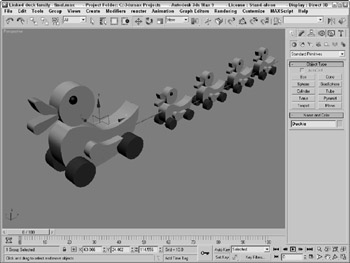Building Links between Objects
The main toolbar includes two buttons that you can use to build a hierarchy: Link and Unlink. The order of selection defines which object becomes the parent and which becomes the child.
Linking objects
 The Link button always links children to the parents. To remind you of this order, remember that a parent can have many children, but a child can have only one parent.
The Link button always links children to the parents. To remind you of this order, remember that a parent can have many children, but a child can have only one parent.
To link two objects, click the Link button. This places you in Link mode, which continues until you turn it off by selecting another button, such as the Select button or one of the Transform buttons. When you're in Link mode, the Link button is highlighted dark yellow.
With the Link button highlighted, click an object, which will be the child, and drag a line to the target parent object. The cursor arrow changes to the link icon when it is over a potential parent. When you release the mouse button, the parent object flashes once and the link is established. If you drag the same child object to a different parent, the link to the previous parent is replaced by the link to the new parent.
Once linked, all transformations applied to the parent are applied equally to its children about the parent's pivot point. A pivot point is the center about which the object rotates.
Unlinking objects
 The Unlink button is used to destroy links, but only to the parent. For example, if a selected object has both children and a parent, clicking the Unlink button destroys the link to the parent of the selected object, but not the links to its children.
The Unlink button is used to destroy links, but only to the parent. For example, if a selected object has both children and a parent, clicking the Unlink button destroys the link to the parent of the selected object, but not the links to its children.
To eliminate all links for an entire hierarchy, double-click an object to select its entire hierarchy and click the Unlink button.
Tutorial: Linking a family of ducks
What better way to show off parent-child relationships than with a family? I could have modeled my own family, but for some reason, my little ducks don't always like to follow me around.
To create a linked family of ducks, follow these steps:
-
Open the
 Linked duck family.max file from the Chap 10 directory on the DVD. This file includes several simple ducks lined up in a row.
Linked duck family.max file from the Chap 10 directory on the DVD. This file includes several simple ducks lined up in a row. -
Click the Select and Link button in the main toolbar, and drag a line from the last duck to the one just in front of it.
Tip You can link several objects at once by highlighting all the objects you want to link and dragging the selected objects to the parent object. This procedure creates a link between the parent object and each selected object.
-
Continue to connect each duck to the one in front of it.
-
Click the Select and Move button (or press the W key), and move the Mommy duck. Notice how all the children move with her.
Figure 10.5 shows the duck family as they move forward in a line. The Link button made it possible to move all the ducks simply by moving the parent duck.

Figure 10.5: Linked child ducks inherit transformations from their parent duck.